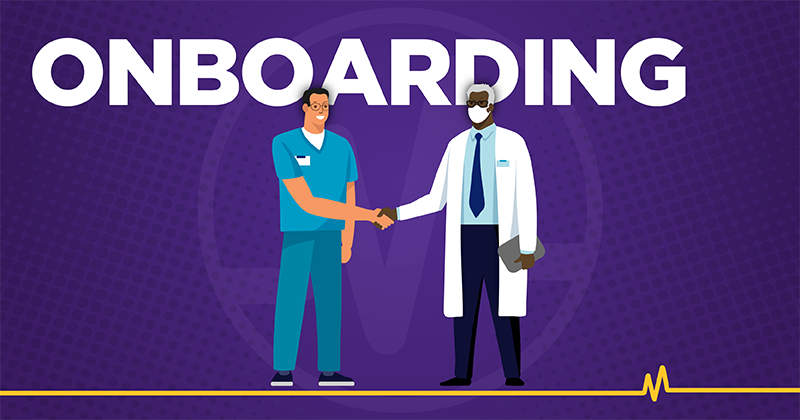Best Practices for Onboarding Physicians in Healthcare

7 Tips for Onboarding New Physicians
It’s tough to be the new guy. Think about the immense amount of pressure on the shoulders of any physician starting at a new practice: new colleagues and staff to meet, a brand new roster of patients and an entirely new EHR system to learn. Regardless of the size of your practice, that is a daunting process for anyone to undergo. Here are some onboarding best practices to ensure healthcare providers experience a smooth transition into their new environment.
Create and Execute an Onboarding Plan
You already know and understand the importance of being organized. Your practice thrives on it. Having a fully fleshed out physician onboarding plan is no different. This is the roadmap that’s going to help you and your new providers reach the intended destination: full integration and assimilation. Communicate the plan and then stick with it. Remember that you’re not just training them on your EHR software. You’re also introducing them to the culture and showing them the way things work in your practice. Providing incoming employees with this roadmap and compass will help ease the transition by setting expectations from the start. This increases feelings of stability, comfortability and self-confidence in your new hires and improves the chances that they’ll stay with your practice.
Remember to keep your plan as streamlined as possible. Requiring new doctors to undergo a million tedious tasks and learn 10 new programs when they start can cause frustration, leading to a high-stress environment that can be unhealthy for care providers and ultimately, for patients.
Having an all-in-one software that handles EHR, PM, payment options, patient engagement, and more can help simplify the onboarding process. With only one program to learn, your providers will have more time to do what they do best.
Prioritize the Security of Your Patients and Practice Data
The importance of keeping the sensitive information of your providers, patients and practice safe cannot be overstated. Maintaining HIPAA requirements and validating the safety of all the data that enters and leaves your practice starts with proper training of every new staff member coming in.
Communicate Values and Mission
This is your chance to really showcase your company culture, values and goals. Be clear and concise, but reiterate what truly matters, first and foremost. Reinforce the value of quality patient care – which starts long before your patients ever walk through the door – from providing easy-to-use engagement tools that allow your patients to take their healthcare into their own hands to the importance of face-to-face interactions that patients crave and deserve. Looking away from your patient to stare at a screen can create a barrier between doctors and patients, causing patients to feel unheard and misunderstood. In today’s digital age, it can be difficult to ensure you’re providing the highest level of empathetic care to every patient individually. Take this opportunity during the provider onboarding phase to remind your physicians of the reasons they entered the healthcare profession to begin with.
Create Networking Opportunities for New Physicians
Provide a safety net for your doctors and staff. Give them the opportunity to meet, engage with, and get to know other providers internally within the practice and externally in the surrounding community. It can be helpful to assign a mentor or ambassador as part of the clinician onboarding process, so your new providers have someone they can go to with questions, recommendations and referrals, even after the initial training stage.

Ask for Feedback about the Onboarding Process
Much like an interview, the process of onboarding a physician is every bit a learning opportunity for you as it is for your new employees. Remember to maintain an open forum throughout the onboarding experience – ask for feedback on how the process has been for them. Is the EHR training running smoothly? Are there any areas where they’d benefit from additional training or support? Keep an open mind, as every physician is different and some employees may benefit from small tweaks to your plan.
Track Progress and Growth
Here’s where it’s going to be crucial to have an excellent implementation team. Your clinicians can learn so much from the training staff at your practice. But do you also have support from your EHR and PM software provider?
At ModMed, we provide an entire team of trainers and support staff to guide you every step of the way – not just during the initial implementation stage, but including educational guides, webinars, FAQs, and a live technical support team available at a click.
Review and Improve the Onboarding Plan
Once the new physician onboarding process is complete, revisit the feedback you received from your doctors, consider the progress of your recent hires, and note if there were any speed bumps along the way. Ask your staff if they would add or improve any part of the training they received. Every good care provider knows there is no one-size-fits-all treatment plan for every patient. EHR onboarding is no different. Within every practice, each provider will have his/her own individual needs and preferences. It’s imperative to be sensitive and responsive to those needs so your physicians can feel at ease and welcome in their new environment.
Incorporating an all-in-one EHR + Patient Engagement + PM solution that’s versatile enough to facilitate all the needs of your practice could help your incoming physicians deftly maneuver through the onboarding process so they can move on to what matters most – their patients.

Interested in how a modern EHR and practice management technology can help you streamline and simplify the onboarding process? Request a demo or check out some of the other resources below.




